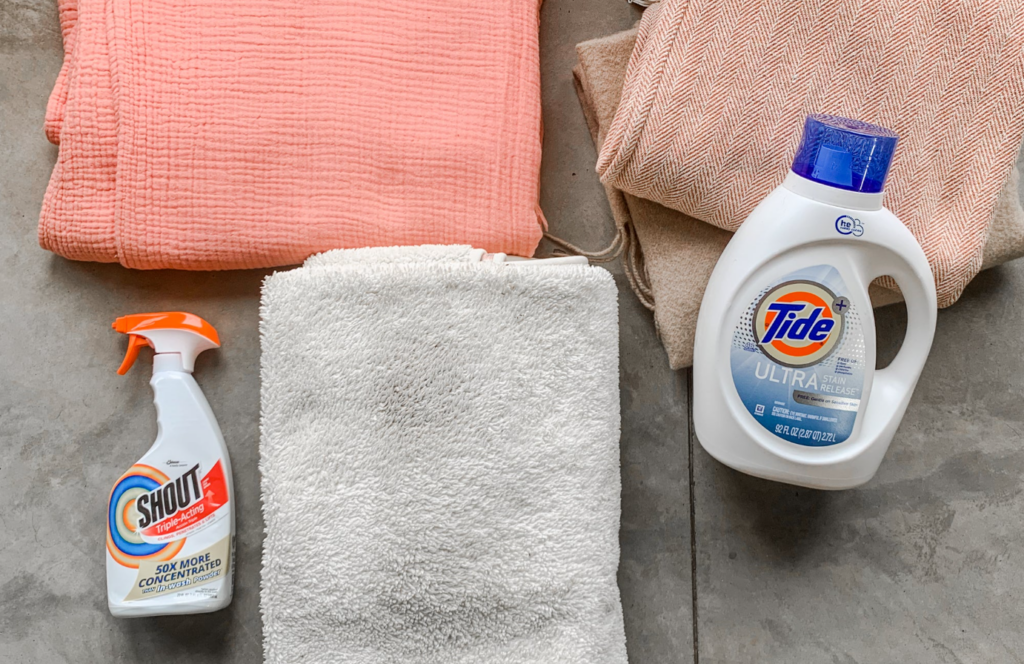Many wonder about the best practices for how to wash fleece blanket, aiming to keep them clean while preserving their durability and fresh appearance. Fleece blankets, known for their warmth and comfort, often come with a bit of a maintenance puzzle.
It’s true that while fleece blankets boast durability and a lengthy lifespan, improper care can lead to reduced durability, with the blankets prone to quick wear, stretching, sagging, and pilling.
However, there’s no need to worry! With the right approach, you can easily maintain the quality of your fleece blankets. Understanding the dos and don’ts of washing fleece is key to keeping these cozy companions in top condition for years to come. Let Ginger Glow guide you through the process of how to wash fleece blanket in just ten minutes! Dive into our article for all the tips and tricks you’ll need.
Why Fleece Blankets Make the Perfect Gift?
Before diving into the intricacies of how to wash fleece blanket, let’s take a moment to appreciate the charm of fleece blanket gifts.

Comfort and warmth for your loved one
These blankets are not just any ordinary gifts; they are symbols of luxury and comfort. With their plush and fluffy texture, fleece throw blankets, fleece tie blankets add a touch of sophistication and warmth to any bedroom, enhancing the ambiance with their cozy appeal. High-quality fleece blankets offer unparalleled comfort, making them versatile companions for various seasons.
Versatility of use
Fleece blankets go far beyond their basic function of providing warmth during sleep; they play a versatile role in home decor as well. These cozy blankets can transform into stylish sofa throws or even chic floor coverings, adding an extra layer of warmth and luxury to any living space.
Their plush texture and variety of colors and designs enable fleece blankets to seamlessly integrate into various interior styles, from modern minimalism to rustic charm. By draping a fleece blanket over a sofa or using it as a soft, inviting carpet, you can effortlessly enhance the aesthetic appeal and comfort of your home, making it a more welcoming and cozy environment for both family and guests.
Personalization options
The distinctiveness of fleece blankets has made them popular choices for various occasions. Whether it’s for housewarming, Christmas, Mother’s Day, or a birthday, a fleece blanket serves as a thoughtful and cherished present.
It’s their ability to blend luxury with practicality that makes fleece blankets highly sought-after gifts, appreciated by recipients for both their aesthetic appeal and functional warmth.
How to Wash Fleece Blankets in 10 minutes?
How to wash fleece blanket? Here’re the tips for you.
Pre-wash Considerations

Before learning how to wash fleece blanket, let’s see the pre-washing process. Pre-washing plays a pivotal role in the maintenance of your fleece blanket, crucial for eliminating persistent grime and ensuring your health over prolonged usage. Keeping your blanket pristine not only extends its life but also safeguards against potential skin and respiratory conditions.
Step 1: Inspect for Stains
Often overlooked, this step is critical in how to wash fleece blanket. A thorough inspection allows you to identify and decide on the most effective method to remove the dirt, ensuring it doesn’t get ingrained further or become more attached to the fabric during the wash.
Step 2: Rinse Off Dirt
Rinse off dirt when you find out how to wash fleece blanket, such as soil, dead skin cells, and pet fur, which can cling to your blanket. Rinsing them off prevents water from binding these particles more firmly to the fabric.
Removing dry stains beforehand simplifies and enhances the efficacy of your cleaning efforts. Alternatively, a mini vacuum cleaner can be employed to dislodge fine dust and debris from the blanket.
Step 3: Treat Stains
For more stubborn stains, pre-treat them with a gentle detergent before proceeding how to wash fleece blanket, either by machine or by hand. This pre-treatment step is essential for loosening and lifting stains, ensuring a thorough clean without harming the fabric’s integrity.
Step-by-step Washing Instructions
The tips for how to wash fleece blanket require a gentle approach to maintain their softness, structure, and color. Harsh detergents and improper washing techniques can damage both natural and synthetic wool blankets, shortening their lifespan and affecting their aesthetic appeal. Here’s a detailed guide to ensure your fleece blankets remain in pristine condition:

1. Avoid Harsh Detergents
About how to wash fleece blanket, strong detergents, washing powder, and soap can cause natural wool blankets to shed, stretch, and discolor. Opt for mild detergents like shampoo, shower gel, or diluted laundry detergent that clean effectively while preserving the blanket’s quality and appearance.

2. Understand Your Blanket’s Material
If you want to know how to wash a fleece blanket and keep it soft, knowing whether your blanket is made from natural or synthetic wool is crucial. Natural wool requires more delicate handling, often necessitating hand washing or professional cleaning to avoid damage. Synthetic wool is more forgiving but still benefits from gentle washing practices.
3. Pre-Washing Steps
- Inspect the fleece blanket for stains and treat them with mild detergent.
- Rinse off loose dirt and dust, using a mini vacuum cleaner for fine particles.
4. Washing Temperature
Can you machine wash a fleece blanket? The answer is Yes. Use warm water (35 – 40°C) to wash your fleece blankets. Cold water can alter the wool’s structure, while hot water may cause deterioration. Maintain this temperature throughout soaking, washing, and rinsing.
5. Gentle Washing Techniques
Avoid rubbing or wringing the fleece blanket harshly. Gently massage stained areas with a diluted detergent solution. Rinse thoroughly with warm water, ensuring all soap is removed.
6. Drying
Lay the fleece blanket flat on a large surface to dry, avoiding hanging which can lead to stretching. Keep it out of direct sunlight to prevent fading and structural damage. A fan can expedite drying, but avoid high heat sources like heaters and dryers.
Drying and storage tips

Preserving and caring for fleece blankets after washing, especially those made from sheep wool, requires some specific attention to ensure they remain in top condition. While the basic principles of blanket care apply, woolen products demand a bit more diligence due to their natural fibers. Here’s a concise guide to help you maintain the beauty and durability of your fleece blankets:
- Washing: Many contemporary fleece blanket products are machine washable in normal water, making them relatively easy to care for. However, for an added layer of precaution and to ensure your blanket retains its ‘like new’ quality, opting for dry cleaning is advisable. This method is gentle on the wool fibers, preserving the blanket’s texture and appearance.
- Avoid Harsh Treatments: When maintaining your fleece blanket, steer clear of drying, ironing, or applying bleach directly onto the fabric. These harsh treatments can lead to fading and damage the delicate wool fibers, compromising the blanket’s warmth and softness.
- Drying Tips: To prevent color fading, especially when drying under the sun, turn the blanket upside down. This simple step can significantly reduce the risk of sun damage, ensuring the colors remain vibrant for longer.
- Regular Maintenance: To keep your fleece blanket dust-free and fluffy, make it a habit to brush and shake it out regularly. This not only removes surface dirt and debris but also helps maintain the wool’s natural texture.
- Moisture Control: Wool can absorb moisture from the air, which may lead to a musty smell or even mildew. Regularly airing out the room by opening windows can prevent moisture buildup, keeping your blanket dry and fresh.
Common Mistakes to Avoid
The common misconceptions about washing wool blankets can lead to poor hygiene practices and potentially damage the fabric. Here’s a guide to effectively clean your fleece blankets while maintaining their quality and longevity:
1. Use Mild Detergents:
The notion that wool blankets require minimal washing is misleading and can compromise cleanliness. Instead of relying solely on water and sun-drying, opt for mild detergents such as shampoo, shower gel, or detergents formulated specifically for wool. Dilute the detergent to prevent it from penetrating too deeply into the fleece, which could be hard to rinse out completely.
2. Manage Damp Conditions:
During rainy seasons, consider switching to a new bedding set instead of using a damp fleece blanket, which can harbor a musty smell. If your blanket gets wet, use dryers, cool dryers, or fans to expedite the drying process, ensuring no lingering odors remain.
3. Avoid Strong Detergents:
Harsh chemicals, particularly those high in alkalinity or containing biological enzymes, can damage the delicate structure of wool blankets, leading to stretching, skewing, and shape alteration. Opting for the gentler cleaning solutions mentioned can not only preserve your blanket but also save money in the long run by avoiding frequent replacements.
4. Correct Water Temperature:
While some may believe that cold water is safest for wool, the ideal washing temperature is actually around 35-40 degrees Celsius, with 30 degrees as the standard. Extreme temperatures can adversely affect the fabric’s structure.
5. Gentle Handling:
How to wash fleece blanket in washing machine? Fleece blankets become significantly heavier when wet, tempting some to wring them out forcefully or use the highest spin setting on their washing machine. However, the loose connections between the large fleece fibers make them susceptible to damage from such force.
Use a specialized laundry bag if machine washing, and select a gentle wash mode. When drying, lay the blanket flat on a spacious surface rather than hanging it, to preserve its shape and prevent stretching.
Choosing the Right Fleece Blanket
The harsh cold of winter creates a requirement for softness, warmth, and comfort for this seasonal blanket line. It’s no surprise that wool blankets have become a staple product during cold days.
The product is extremely popular in temperate countries. The superior heat retention ability is rated much higher than traditional blanket models.
Normally, fleece blankets usually have 2-3 layers. The product can be made from pure natural sheep wool or use artificial wool. The application of modern technology ensures quality standards on each finished product. You will not have to worry too much about the health of your loved ones.
Factors To Consider: Material Quality, Size, And Design
Natural Fleece Blanket: A Comprehensive Guide

| Advantages | – Durability: Enhanced by modern production techniques, fleece blanket retain the exceptional qualities of raw fibers, ensuring they remain intact, without bunching or deforming, even after extensive use. This durability allows them to be used for decades without showing signs of wear. – Superior Warmth: Engineered with a minimum of 144 threads, these blankets are designed to maintain their shape and offer consistent warmth. The strategic arrangement of wool fibers ensures an optimal thickness and even distribution across the blanket, providing comprehensive warmth that envelops the entire body. Moreover, the natural scent of sheep wool has been known to promote blood circulation, potentially aiding in the prevention of conditions like stroke, heart failure, and bronchitis by ensuring a free flow of blood throughout the body. – High Safety: Thanks to their breathability, wool blankets prevent issues like overheating, breathlessness, and sweatiness during sleep, making them a safe choice for a comfortable night’s rest. |
| Challenges | – High Cost: The scarcity of natural wool, partly due to reduced sheep populations and the impacts of climate changes like drought, makes these blankets more expensive. With the sheep count in Australia dropping significantly since the early 21st century, the price of wool blankets has seen a rise. – Complex Care: The maintenance of wool blankets is not straightforward. Buyers often receive detailed care instructions to preserve the blanket’s quality over time, including recommendations for dry cleaning and advice to minimize washing. This can pose a challenge for households, especially those with young children. – Potential for Allergies: While some individuals may experience itching or allergic reactions to animal-based products, others find they adjust more comfortably to synthetic alternatives. Additionally, the ethical considerations surrounding the sourcing of natural wool have drawn scrutiny from animal rights organizations, adding another layer of consideration for potential buyers. |
Synthetic Fleece Blanket

| Advantages | – Cost-Effective: Unlike their natural counterparts, synthetic fleece blanket items are much more affordable, addressing the economic challenges associated with natural scarcity. Produced seasonally, the high costs and limited availability of natural wool make it a luxury beyond the reach of the average consumer. Synthetic wool emerges as the perfect solution to this dilemma. – Lighter Weight: Originating from polyester, synthetic wool undergoes a process of refinement and spinning into fibers. This production method results in a clean, lightweight fabric. Sometimes, these fibers are blended with natural materials like wool or thistle oil to enhance durability and functionality, allowing for easy color customization. Compared to natural wool, synthetic fabrics are softer, lighter, and do not retain moisture. – Efficient Warmth: Born from the chemical reaction between petroleum and its derivatives, synthetic wool blankets offer excellent insulation and breathability. Their unique structure, featuring numerous air pockets, allows for efficient air circulation, preventing any feeling of stuffiness. The dual-sided design ensures the blanket’s softness is uniformly maintained throughout. – Hypoallergenic: Many users have reported a lack of allergic reactions, such as itching or rashes, often associated with natural wool. This makes synthetic wool blankets a more accessible option for a wider audience, offering a more budget-friendly alternative without compromising on size or weight. |
| Chalenges | – Complex Cleaning: Wetting thick products is generally discouraged, as water can affect the fiber’s bond and structure. Careful maintenance is required to avoid excessive laundering. – Environmental Impact: Though synthetic fibers offer a commendable quality comparable to natural options, their environmental friendliness is debatable. Since synthetic fibers are primarily recycled from plastics like water bottles and cups, this solution falls short of being considered sustainable. |
And hey, we at GingerGlow bring you some good choices of an ideal fleece blanket. Take a look!

Wrapping Up The Guide
To address the common concerns of many, Ginger Glow is here to provide a comprehensive solution for how to wash fleece blanket. With this guide, we hope to demystify the process, making it straightforward and manageable for everyone. Our aim is for you to feel confident in cleaning your fleece blanket, ensuring it remains a cozy, cherished part of your home for years to come.
Furthermore, if you’re on the hunt for the perfect fleece blanket to gift someone special, remember to explore Ginger Glow‘s selection. Our collection boasts artistic and sophisticated options that promise not only warmth and comfort but also a touch of elegance to any space. Don’t miss the opportunity to find a beautiful, thoughtful gift at Ginger Glow.


